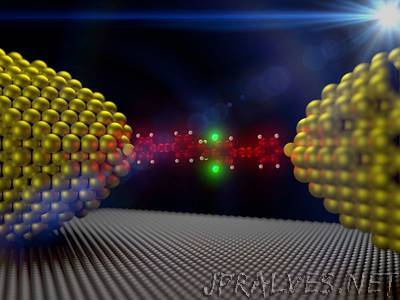
“Diodes are the ‘traffic lights’ of electrical devices: they determine whether or not electricity is able to pass through a circuit. Chip manufacturers strive to make them as small as possible, so that they can fit the maximum possible amount of components on a chip. When the ‘lights’ are green, the diodes need to ensure a good flow of traffic, but they also need to ensure that as little electricity as possible can ‘jump the lights’ when they are red. TU Delft researchers have successfully manufactured a diode using just a single molecule. At 600, this diode’s ratio of red to green (in technical jargon: its rectification ratio) is significantly higher than in earlier research (15). The researchers were also able to make the diode ‘tuneable’ for the first time. They recently published their research in the international journal Nanoscale.
Moore’s law
In line with Moore’s law, electrical components such as diodes and transistors are getting smaller and smaller, and computers are getting faster. Researchers are currently conducting fundamental research into components consisting of individual molecules – in theory the smallest possible components. ‘The first single molecule diode was created in 2005,’ explains doctoral candidate Mickael Perrin. ‘It works, but up until now, diodes like that were pretty poor traffic lights: about ten times as much electricity passed through when the ‘lights’ were green than when they were red. To stick with the traffic light analogy, you could say it resulted in considerable chaos on the roads. It is not very impressive when compared to the ratios of classic diodes, in your laptop, for example. They achieve ratios of up to 10,000 or 100,000’.
Tunable
Perrin and his colleagues developed a diode based on an artificial molecule, with which they achieved a red/green ratio of 600. ‘That is much higher than in previous research. Our molecule features a benzene ring on both sides, enclosing an ethane bridge. The bridge – actually a barrier – allows the electricity to flow when the energy levels are equal on both sides, but not if they are different,’ explains Perrin. ‘Another significant result from this research is that we are able to tune this diode using an electrical field: we can use a gate electrode to adjust the energy levels, thereby adjusting the red/green ratio. That can be as low as 50, but up to 600. The gate allows us to set the ratio to the desired level, ensuring that the diode works efficiently.’
Collaboration
The research project is a collaboration between nano-scientists from the Kavli Institute of Nanoscience (Mickael Perrin, Jos Thijssen and Herre van der Zant) and chemists from the Chemical Engineering Department at TU Delft (Elena Galan, Rienk Eelkema and Ferdinand Grozema). What is currently purely fundamental research could eventually lead to even smaller electronical devices and more energy-efficient computers. The research was financially supported by the Foundation for Fundamental Research (FOM), part of the Netherlands Organisation for Scientific Research (NWO).”
